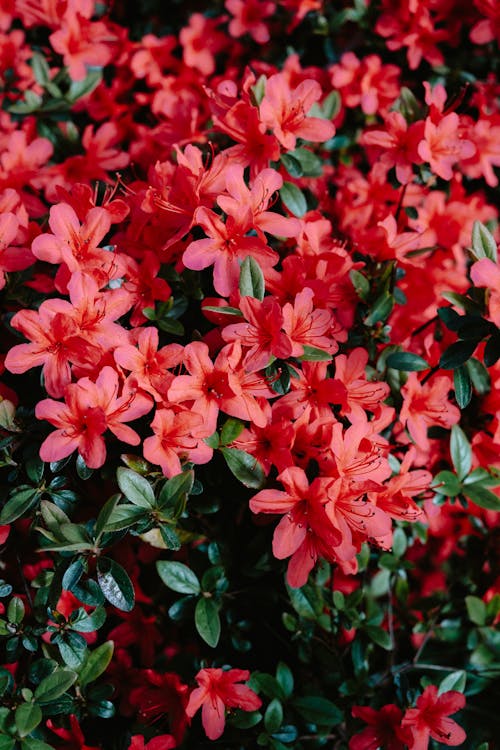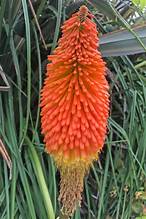List of Red Flowers to Grow for a Stunning Garden (Flower with pictures)
Red is a vibrant color that draws attention, which is why stop signs and traffic signals use it. Red flowers in the garden serve the similar role of drawing attention and standing out from a distance. Red flowers also attract a number of pollinators, including butterflies and hummingbirds.
From delicate rose to vivid vermilion, there’s a shade of red to fit every color palette in your garden. Mix red flowers with orange, yellow, and hot pink ones for a tropical effect. Alternatively, mix several colors of red to create a visually attractive monochromatic appearance. But be aware that if utilized excessively, vivid red blooms can become overbearing. Place them where you want people to notice them in your garden for the best impression.
Explore the colorful world of red flowers! Use our guide (flowers and names ) to transform your garden featuring beautiful blooms, expert tips and stunning visuals
Azalea

This flowering species , which grows well in zones 6 – 9, prefers full sun to partial shade. It can grow up to 3 feet tall and 2 feet wide when in full bloom, which occurs from spring until mid-fall.
This azalea shrub blooms twice a year, in spring on old wood and again in July on new wood, adding brilliant color to your landscape from spring through autumn. Like all azaleas, it prefers acidic soil for optimum growth.
Bee Balm

This perennial flowering plants grows best in full sun to part shade and is appropriate for zones 4 – 9. It reaches a height of 14 to 18 inches and a spread of 10 to 12 inches, blooming from mid- to late summer.
For the most part of the summer, this little bee balm produces an abundance of cherry red flowers. In addition to being visually stunning, the vivid blossoms draw hummingbirds, butterflies and bees.
Bleeding Heart

This flowering plant prefers partial to full shade and grows well in zones 3 – 9. It is 28 to 30 inches tall and wide when it blooms in late April.
Deep red and white flowers with arching stalks dangle from this traditional bleeding heart variant. Although this plant dies down after flowering, the blossoms persist for a few weeks and then come again in the next spring.
Calibrachoa
 Plant types which are typically planted as an annual, thrives in zones 9 – 11 and likes full sun to partial shade. It grows to a height of 6 to 12 inches and a width of 12 to 24 inches while in bloom from the time of planting to the first frost.
Plant types which are typically planted as an annual, thrives in zones 9 – 11 and likes full sun to partial shade. It grows to a height of 6 to 12 inches and a width of 12 to 24 inches while in bloom from the time of planting to the first frost.
This strong bloomer has dark crimson centres and deep pomegranate-red flowers that last all season. It makes a good groundcover that grows quickly and is perfect for rapidly filling window boxes, pots, and hanging baskets. Even though the flowers can take care of themselves, sometimes trimming them helps encourage better branching and a more dense appearance.
Calla Lily

Usually cultivated as an annual, this plant flowers with red color blooms grows best in zones 8 – 13. It prefers full sun to partial shade. It reaches a height of 18 to 24 inches and a width of 9 to 12 inches when it blooms, which occurs from early to late summer.
Spathes, or deep red tubular bracts, bloom over several weeks. They give borders, bulk plantings, and containers durable colour. This gorgeous tropical plant can also be grown indoors as a houseplant.
Canna

This plant species Grown as an annual in Zones 2–7, this plant is a perennial in Zones 8–10. It flowers in the early to midsummer and persists until frost in full sun to partial shade. It reaches a maximum height of 30 to 48 inches and a maximum width of 18 to 24 inches.
Cannas’ vivid foliage and vibrant flower colors create a striking visual effect. These are tropical plants, which enjoy humidity and heat. Because they can withstand standing water, cannas are perfect for bog gardens or the edges of ponds.
Cardinal flower

This perennial prefers full sun to partial shade, and it grows well in zones 6 – 10. It reaches a height of 22 to 28 inches and a width of 16 to 22 inches when it blooms, which occurs from July to early autumn.
This plant, which looks great in moist or damp areas, has elegant stalks of crimson-colored flowers and bronze-colored leaves that hold their colour year-round. Rain gardens, borders, and waterside gardens are all great uses for it.
Chrysanthemum

This perennial types of flowers likes full light and grows well in zones 5 – 9. It reaches a height of one to three feet and a spread of one to two feet when it blooms, which occurs from late summer till frost.
These blooms, sometimes referred to as mums, are a garden staple during autumn. They are available in deep, autumn colors like burgundy and red. Select resilient perennial flowering varieties when purchasing garden mums. Mums used in floristry won’t survive the freezing and thawing cycles of winter.
Coneflower

This perennial plant types likes full light and grows well in zones 4 – 8. It reaches a height of 26 to 28 inches and spreads 16 to 20 inches broad when it blooms in the middle to late summer.
Although most people associate purple coneflowers with beauty, there are many more striking colour variations available, such as this vivid scarlet-orange one. It is easy to grow, resistant to heat and drought, and produces months of nonstop blooms, much like all coneflowers.
Coreopsis

This perennial plant likes full light and grows well in zones 5 – 9. It is 8 to 12 inches tall and spreads 10 to 15 inches wide when it blooms, which occurs from early summer to early fall.
All summer long, this hybrid Coreopsis displays gorgeous burgundy red blooms. Because the plants concentrate their energy on making more blooms rather than seeds, its sterile blossoms guarantee continual flowering. To stimulate a new flowering wave, just prune back any plants that appear to be waning.
Daylily

This perennial prefers full sun to partial shade, and it grows well in zones 6 – 10. It reaches a height of three feet and a width of two feet when it blooms in the early summer.
This striking daylily is a real showstopper, especially in big plantings, with its enormous 9-inch ruby red flowers accented with golden yellow edges. The plant bears many buds, which guarantee weeks of continuous blooms even though each flower only lasts a single day.
Dipladenia

This plant, which is usually cultivated as an annual, grows best in zones 10–11 and likes full light. Growing up to two feet tall and wide, it blooms from the time of planting until the first frost.
This plant features unusual trumpet-shaped flowers and is closely related to the mandevilla vine. It’s small enough to fit in hanging baskets or containers. From July to autumn, the intensely crimson blossoms bloom continuously, drawing butterflies and hummingbirds with their irresistible charm.
Geranium

This types of plant species, which is usually cultivated as an annual, grows best in zones 9 – 11 and likes full to partial light. From the time of planting until the onset of cold, it blossoms, growing to a height of 10 to 12 inches and a width of 12 to 20 inches.
Vibrantly blooming summer plants set against verdant foliage always make for an eye-catching mix. You can prune your geraniums and bring them inside for the winter if you have a sunny window.
Gerbera Diasy

This flowering plant, which is usually planted as an annual, grows best in zones 9 – 11 and likes full sun to partial shade. It reaches up to 12 inches in height and spread when it blooms, which occurs from late spring to autumn.
Gerbera daisies come in an amazing range of colors, but the flower red color stand out the most because of their petals, which resemble rays and encircle either a dark or light center. For trimming containers and gardens, they are ideal.
Hibiscus

This perennial plant prefers full sun to partial shade, and it grows well in zones 4–9. From summertime to early fall, it blooms, reaching a height of 4 to 4-1/2 feet and a width of 5 feet.
The dense, almost-black foliage of this plant is exquisitely complemented by the approximately 9-inch-wide, rich, deep crimson blooms. Rose mallow is a robust hibiscus that can survive winter outside in colder locations, in contrast to tropical hibiscus.
Hydrangea

This shrub does best in zones 3–8, and it likes full sun over partial shade. Reaching heights and spreads of three to five feet, it blooms from early to late summer.
This fascinating hydrangea features four distinct blossom colours on one plant. Lime green at first, the blooms progressively turn white, pale pink, then Hawaiian Punch crimson. All four hues are present simultaneously when it reblooms in the summer.
Impatiens

This plant, which is usually cultivated as an annual, grows best in zones 10–11 and likes full to partial shade. It blooms from the time it is planted until it freezes, growing to a height of 10 to 20 inches and a width of 12 to 24 inches.
This plant bears soft, double flowers that, when in bloom, resemble little red roses. From spring until autumn, it develops a perfectly spherical mound that is covered in self-cleaning blooms.
Kniphofia

This perennial flowering plant likes full light and grows well in zones 6–9. It reaches up to 3 feet tall and spreads up to 2 feet broad during its early to late summer bloom.
Kniphofia, often called torch lily or red-hot poker, gets its name from its tall, vividly coloured blossoms. As they mature, its blossoms take on a distinctive bi-color metamorphosis. Like a rocket in flight, these flowers begin as upright spikes of red flower buds that gradually open into creamy yellow blossoms from bottom to top.
Lantana

Tender perennial, best planted as an annual, this plant thrives in zones 9–11 and needs full light. It reaches heights and spreads of one to two feet as it blooms from the time of planting until the first hard frost.
This heat- and drought-tolerant blooming frequently has several flower colours on one plant, making it an impressive addition to garden beds or containers. Although lantana is usually cultivated as an annual, in areas with warm winters, it can bloom almost all year round.
Nemesia

This annual grows well in both partial shade and full sun. It grows to a height of 6 to 10 inches and a width of up to 18 inches, blooming from the time of planting until the first frost.
Nemesias usually prefer cooler spring and autumn conditions, but this particular variety is quite tolerant of both, blooming profusely all summer long. Because of its trailing growth, it’s ideal for bringing vivid colour to window boxes and hanging baskets.
Oriental Poppy

This perennial plant likes full light and grows well in zones 5-7. It reaches up to three feet in height and two feet in width when it blooms, which occurs in late spring or early summer.
With its huge scarlet-orange blossoms that may measure up to 8 inches across, the flamboyant Oriental poppy captures attention in the garden throughout its limited flowering season. Since these plants lose their leaves in the summer, they are perfect for blending in with other tall perennials or annuals to hide the fading foliage.
Petunia

This annual flowers from the time of planting until the first hard frost and does best in full light. It spreads 18 to 24 inches wide and grows 6 to 10 inches tall.
Throughout the summer, this true red petunia blooms nonstop and doesn’t require deadheading. It is low maintenance and easy to cultivate. Plants with more fullness produce more flowers when they receive occasional gentle trimming. As long as there is no chance of frost, petunias can tolerate lower temperatures even if they prefer the heat.
Phlox

This annual flowers from the time of planting until the first hard frost and does best in full light. It usually spreads 18 to 24 inches broad and grows 6 to 10 inches tall.
From early spring through autumn, this flaming red phlox blooms freely and doesn’t need to be deadheaded. It is a good choice for drier locations because it is very heat and drought tolerant and requires less frequent watering than many other flowering annuals.
Rose

This shrub likes full sun and grows well in zones 4–9. It blooms from the beginning until the end of summer, growing to a height of three to four feet.
Without roses, no list of red flowers would be complete. Set against glossy green foliage, this variety features beautiful, completely double red blooms on long stems. Because of its disease resistance and ability to clean itself, it requires little care to maintain its gorgeous appearance all season long.
Weigela

This shrub likes full light and grows well in zones 4–8. It reaches heights and spreads of four to five feet and blooms from late spring to autumn.
This is a reblooming cultivar of weigela; unlike ordinary weigelas, which bloom only in late spring, it blooms on both old and new wood throughout the summer until frost. The lipstick red, tubular flowers are also a great addition to any garden as they draw hummingbirds.
Yarrow

This red flowers plant likes full light and grows well in zones 3–8. It reaches a height of thirty to thirty-six inches and a width of thirty to forty-two inches when it blooms in the early to late summer.
This sun-loving, drought-tolerant perennial plants gives stunning splendor to gardens and creates visually captivating arrangements of cut or dried flowers. The flower clusters with flat tops are perfect for butterflies and other pollinators to land on. After the flowers have faded, cut down plants by half to encourage a second cycle of blooming.




Pingback: 10 beautiful purple flowers
Pingback: Azalea flower Guide: Planting, Growing, and Caring
Pingback: Flowering plants that will attract honey bees
It appears that you know a lot about this topic. I expect to learn more from your upcoming updates. Of course, you are very much welcomed to my website YK3 about Thai-Massage.